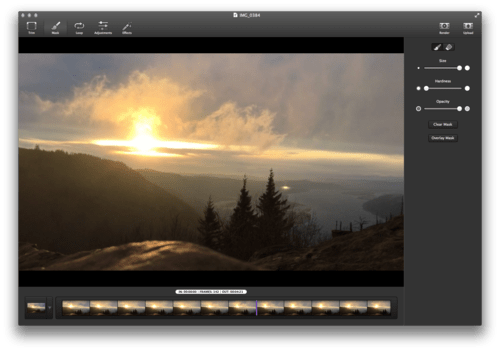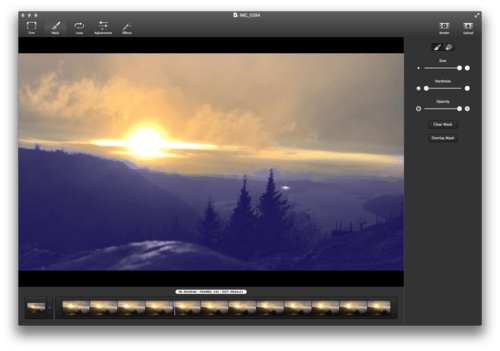CinemaGraph Pro Review

Months ago I acquired CinemaGraph Pro as part of a bundle but I hadn’t taken it for test run until earlier this week. As a hobbyist motion graphics designer (who’s done contract work for three TV shows) and photographer, it intrigued me but I found many of the demos creepy or kinda cheesy.
Recently, I was asked to create a background for video project. Having written a few reviews, including an exhaustive examination of CodeKit, I figured I’d roll two projects into one by reviewing CinemaGraph.
An under hand pitch
CinemaGraph is unusually simple. It’s a one trick pony that allows you to create animated “stills” from a video. The end result is a picture that has selected elements animated, an effect increasingly seen on video billboards in movie theaters and kiosks in malls.
Due to the extreme simplicity of the program, videos thus need to be captured with Flixel in mind: stationary and via tripod. Any other serious processing, such as stabilization or color correction will need to be performed by another video editing or video compositing program. Quite simply, if you do not plan ahead, you probably won’t be able to create meaningful results.
It’s also an effect that can be recreated in Apple’s (extremely more powerful which can be bought for half the price) Motion, Adobe Affect Effects, and even video editing programs such as Final Cut Pro, Adobe Premiere, and Avid Media Composer. Within these programs, it requires a few more steps: a still frame, a masked video layer and then manually looping the video with fade transitions, the last step being the most tedious.
To be fair, Flixel makes achieving this effect much easier than using any of the aforementioned programs.

In action…
For my experiment, I used a time lapse I captured with HyperLapse on my iPhone 6 during a recent wind storm in the Pacific Northwest.
Flixel’s program is incredibly simple, open up a video, trim your loop and then start masking. Your results are revealed in real time. Its fast and its easy.

There’s no keyframes, no animated masks, no video steady cam. The only controls beyond masking are repeat, playback speeds and crossfade duration. The only features are Instagram-like Filters and basic color management.
Anyone familiar with motion graphics or video compositing…. hell, even just Photoshop can pick up and start using Cinemagraph Pro, and that’s a good thing. Flixel deserves kudos for a simple, fun and easy to use application. Without so much as a tutorial, I was able to produce instant usable results first try for a professional project.
Pro though, it is not.
While I’m a proponent of app developers charging sustainable pricing, $99 is stiff. Compare it to other programs in the same price range: Panic Studio’s Coda or Bohemian Coding’s Sketch or Black Pixel’s Kaleidoscope, all less expensive and fully featured seriously pro-applications by written small studios. While none of these programs are video related, each offers an interface design of the same caliber and are for serious creative professionals.
Most telling is that Apple’s Motion, a full blown graphics compositing application costs HALF the money, and is capable of delivering the same results (albeit not quite as easily) and a ridiculous-to-the-point-of-absurdity more features. I just cannot emphasize this part enough.
Flixel does offer some unique features such as the ability capture video and hand off functionality from iOS to OS X. Its nice but not $50-more-than-Motion-nice.

While Flixel allows GIF export, I found it was extremely advantageous to export to video and use GifBrewery to generate my GIFs.
Final Thoughts:
CinemaGraph Pro is fun, but gimmicky. Its a great way to create infinitely looping stills, suited mostly to nature scenes or creepy statue humans. As an avid hiker, I may find mild use for it, and as a front end web developer, it’s yet-another-tool in my expansive arsenal of media apps. While Apple’s Motion can recreate the effect, it’s much more cumbersome. Motion however, can create animated masks, and use vector and raster masks. Even at creating animated “still”, Motion has the upper-hand.
The real problem with Cinemagraph is entirely its price.
Easily the most telling part is the app was temporarily on sale for $15 on the App store after being slashed from $200.
At $99, I cannot in good conscience recommend it to anyone other than working professional who has a seriously need for it. Apple’s Motion is insanely good deal these days. It certainly has a higher learning curve but its fantastically more powerful.
Flixel’s application at somewhere between $15-$25 seems like the correct price. At $99, is a steal, and not for you. Its far too limited. The saddest part is I actually really like CinemaGraph. It’s fast. It’s fun. It works nicely in a motion graphics work flow. I was able to get stellar results first try.
Version reviewed: 1.5